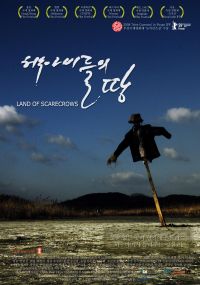Dir: Gyeong-tae Roh
90 mins.
Aspect Ratio: 1.85:1
Ji-Young is a young installation artist. A woman biologically, Young believes herself to be a man. She wears men’s apparel to hide her feminine body structure. During her stay in Philippines
Young manages to persuade Rain to marry her by her convincing dress up as a man. A few days into the marriage, Rain starts feeling cheated and lonely as the couple enjoys no physical relation. One night she discovers Young’s identity and the fact that the “man” she married is actually a woman, dawns upon her. In a torn mental state but not shy anymore, Rain leaves… she meets Loi Tan, a good-looking boy, working as a dishwasher and looking for his father in the Philippines
Rain eventually falls in love with Loi.
Themes
1) An idea of being cheated or snatched off, an identity that one desires
2) A search
The idea of being Cheated
Right from the onset of the movie there’s a delusive element, this I feel is emphasized by the first scene where the scarecrow is set up in a barren land. A scarecrow is used during a full harvest and has no use in a barren land. Young feels cheated by nature for not biologically making her a man. Rain is cheated by Young into believing her and marrying her. Loi Tan is cheated by his parents.
The Search
There’s a sense of incompleteness the 3 characters go through. Young blames her life at the wasteland as the reason for her “transgender-ness”. She wants to be a man. She is searching for that identity and has gone through every possible wayto getherself cured.
Rain is shy, she desires to be a wife to a Korean man. Once married to Young, she desires to be bodily united with ‘him’ and be loved. She fails to achieve this. She feels incomplete and is seen till almost the end, searching for her Korean man.
Tan’s constant search is for his identity as a son to a father who left him. This search brings him to Philippines
Narrator
An omniscient narrator, starts by telling us the story of 3 different people and then knits it all together into one.
Structure and Pace
The film moves in a linear fashion at a uniform pace with no flashbacks or fast forwards. However the movie appears a little slow often, with some frames excellent in composition but with really slow and little action, making you wish it would move a little faster.
The Bed
I don’t to call it a prop as much but the bed I feel, represents Young’s and Rain’s married life. From a cozy place filling the entire screen in the first few times its shown, the bed starts appearing abandoned with crumpled bed-spreads and a part of it starts being excluded as if to emphasize some sort of uncomfortable incompleteness.
The image of the bed once Rain leaves with the bedspread crumpled on one side, strewn clothes all over and Young sitting alone, in its being a representation of the end of the married relationship, even resembles the barren land with a scarecrow at a level.
Light and Setting
Most of the shots appear to be shot in natural light. Shots with vast landscapes emphasize empty spaces. Shots within closed spaces and rooms are dark as if an element of secrecy is present.
Frames
My favourite part of the movie is the way the shots have been framed. The frames are beautiful though simple. The ‘Rule of Thirds’ has been used abundantly, along with the noticeable use of lines in vast landscapes. Shadows and Darkness are complimentary to the mental state of a character being shown.

No comments:
Post a Comment